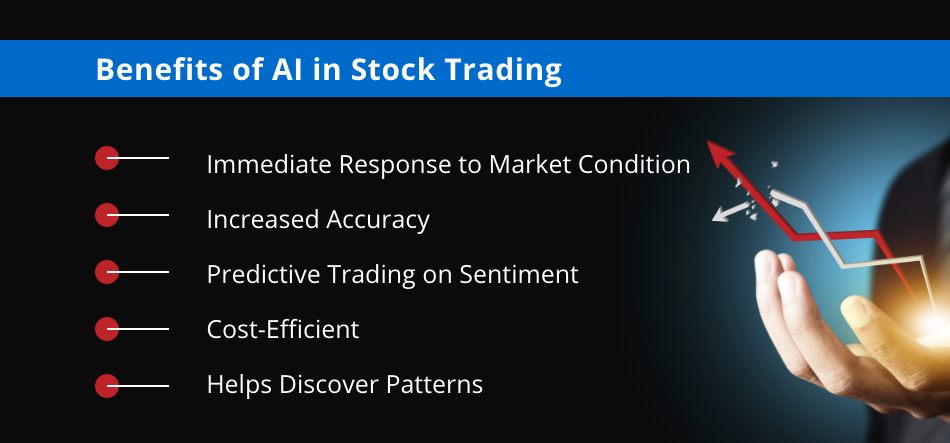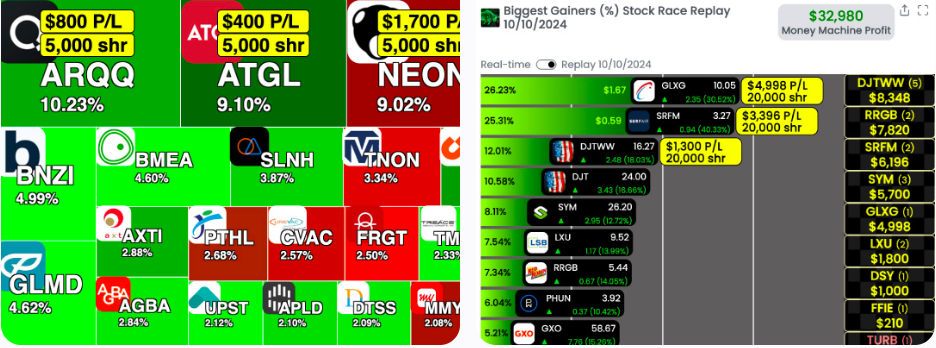In order to provide accurate and reliable information it is essential to verify the data and sources that are utilized by AI stock prediction and trading platforms. Insufficient data could lead to inaccurate predictions, losses of money, and a lack of trust. Here are 10 of the best strategies to evaluate data sources and the quality.
1. Verify the Data Sources
Verify the source of the information. Ensure that the platform relies on well-known, reputable data sources (e.g. Bloomberg Reuters Morningstar, or stock exchanges such NYSE, NASDAQ).
Transparency. The platform must publicly disclose the sources of data it relies on and keep them up to date.
Avoid single-source dependencies: Reliable platforms typically aggregate data across several sources to reduce the chance of errors and bias.
2. Examine the freshness of data
Real-time as opposed to. Delayed Data: Find out whether the platform provides real-time data or delayed information. Real-time data is vital for active trading, while delayed data is sufficient to provide long-term analysis.
Check the update frequency (e.g. minute-by-minute updates, hourly updates, daily updates).
The accuracy of data from the past: Check to ensure that data is uniform and free of any anomalies or gaps.
3. Evaluate Data Completeness
Check for missing or inaccurate information.
Coverage: Ensure that the platform offers a broad selection of markets, stocks indexes, and other equities that are relevant to your trading strategies.
Corporate actions: Ensure that the platform can account for stock splits or dividends. Also, make sure it accounts for mergers.
4. Accuracy of test data
Data consistency can be guaranteed by comparing the data of the platform to other reliable sources.
Error detection: Look for outliers, incorrect pricing or financial metrics that have not in line with.
Backtesting. You can backtest strategies with historical data and then compare the results with what you would expect.
5. Review the data's Granularity
Level of detail: Make sure the platform has granular data, such as intraday price and volume, spreads, bid and ask, as well as depth of the order book.
Financial metrics: Make sure the platform provides complete financial statements, such as the income statement, balance sheet and cash flow. Also, check if it has key ratios such as P/E (P/B), ROE (return on equity) etc. ).
6. Verify that the data is cleaned and Preprocessing
Data normalization. Make sure that the platform is normalizing the data to maintain consistency (e.g. by adjusting splits, dividends).
Outlier handling: Find out how the platform handles outliers or anomalies within the data.
Missing data imputation - Check whether the platform uses effective methods to fill in the data gaps.
7. Verify data consistency
Timezone alignment Data alignment: align according to the same timezone to avoid discrepancies.
Format consistency: Ensure the data is presented consistently.
Verify that the data is consistent across markets: Compare data from various exchanges and/or markets.
8. Determine the relevancy of data
Relevance in your trading strategy. Check that the information is in line with your trading style.
Selecting features: Make sure whether the platform provides relevant features to enhance predictions (e.g. sentiment analysis macroeconomic indicator, news data).
Examine Data Security Integrity
Data encryption - Ensure that your platform uses encryption to safeguard data during transmission and storage.
Tamper-proofing (proof against tampering) Verify to be sure that the data has not been altered or manipulated by the system.
Conformity: See whether the platform complies with the regulations on data protection.
10. The transparency of the AI model's performance on the Platform can be tested
Explainability: Ensure that the platform provides you with insights into the AI model's use of data to make predictions.
Bias detection - Examine to see if your platform is actively monitoring data and models for biases.
Performance metrics: Assess the quality of the platform by evaluating its history, performance metrics, and recall metrics (e.g. precision and accuracy).
Bonus Tips
User reviews and reputation: Research user reviews and feedback to determine the platform's reliability and data quality.
Trial time: You are able to test the data quality and capabilities of a platform with the demo or trial before deciding to purchase.
Support for customers: Ensure that your platform has a robust assistance for issues related to data.
If you follow these guidelines will help you evaluate the data quality and sources of AI platform for stock predictions and make sure you are making informed and reliable trading decisions. Take a look at the top rated the advantage about ai stock picker for more tips including trading with ai, chart ai trading assistant, ai investing, best ai stock trading bot free, trading with ai, best ai stock trading bot free, best ai trading app, trading ai, stock ai, ai chart analysis and more.

Top 10 Tips To Evaluate The Risk Management Of Ai Stock Prediction And Analysis Of Trading Platforms
Risk management is an important aspect of every AI trading platform. It can help protect your investment while minimizing the risk of losses. Platforms with robust risk-management tools can assist you in navigating volatile markets and make educated choices. Here are 10 tips on how to assess the risk management capabilities of the platform.
1. Review Stop-Loss and take-profit features
Customizable levels - Make sure that the platform allows you customize your stop-loss, take-profit and profit levels for each strategy or trade.
Check the platform to see whether it has a trailing stop feature, which will adjust automatically in the event that the market changes in your direction.
If the platform provides stop-loss orders that guarantee your position is closed to the specified price in volatile markets and you are assured that you will be able to trade successfully.
2. Tools to Measure Positions
Fixed amount: Make sure the platform lets you define positions based on a certain amount of money that is fixed.
Percentage: Check whether you are able to determine your positions' sizes in proportion to the value of your portfolio. This will help you manage risk in a proportional way.
Risk-reward: Make sure your platform lets you define risk-rewards for each trade or strategy.
3. Look for assistance with diversification
Multi-assets trading: Verify that the platform supports trading across multiple asset categories (e.g. ETFs, stocks options, forex, etc.) for diversification of your your portfolio.
Sector allocation: Find out whether the platform has tools to monitor and manage the exposure of sectors.
Diversification of the geographic area. Check to see if your platform allows the trading of international markets. This will aid in spreading the risk across different geographic areas.
4. Evaluation of Leverage and Margin controls
Margin requirements: Make sure the platform is clear about limitations on margins when trading leveraged.
Limits on leverage: Find out if the platform allows you to set leverage limits to limit risk exposure.
Margin calls: Make sure you get prompt messages from the platform to ensure that your account is not liquidated.
5. Evaluation of Risk Analytics and Reporting
Risk metrics: Check whether the platform has key risk metrics, such as Sharpe ratio and Drawdown, to help you manage your portfolio.
Scenario evaluation: Make sure the platform you are using lets you simulate market scenarios and assess risk.
Performance reports: Check whether the platform provides specific performance reports with the risk-adjusted return.
6. Check for Real-Time Risk Monitoring
Portfolio monitoring. Make sure your platform can track in real-time the risk associated with your portfolio.
Alerts and notifications. Ensure that the platform is sending out alerts at the moment that risk events occur (e.g. Margin breaches or triggers for stop-loss order).
Risk dashboards – Check to see if the platform you are using offers customizable risk dashboards. This will give you more information about the risks you are facing.
7. Test Stress Testing and backtesting
Stress testing - Make sure your platform allows you stress test portfolios and strategies under extreme market situations.
Backtesting Check if platform supports backtesting using historical data to evaluate risk and performance.
Monte Carlo Simulators: Verify whether the software uses Monte Carlo models to model possible outcomes and evaluate risks.
8. Risk Management Regulations Compliance Assessment
Check that the platform satisfies the requirements of regulatory compliance (e.g. MiFID II regulations in Europe, Reg T regulations in the U.S.).
Best execution: Verify that the platform follows the most efficient execution methods. Trades are executed at the most affordable price that is possible in order to reduce the chance of slippage.
Transparency: Make sure that the platform has clear and transparent disclosures about the potential risks.
9. Examine for Risks that are User Controlled Parameters
Custom risk rule: Check that your platform permits you to set up your own risk management rules (e.g. the maximum daily loss, or maximum size of the position).
Automated risk controls: Determine whether the system can automatically enforce rules for risk management based on your predefined criteria.
Manual overrides: Check whether the platform permits manual overrides to automate risk controls in the event of emergency.
Review of User Feedback and Case Studies
User feedback: Review the opinions of users to assess the platform's capability to control risk.
Case studies: Search for examples or testimonials that demonstrate the platform's risk management capabilities.
Forums for communities. Find out if the platform is a thriving user community, where traders exchange risk management strategies and suggestions.
Bonus Tips
Free Trial: Try out the platform's features for risk management in real scenarios.
Customer support: Ensure you have a reliable support system in relation to risk management problems or queries.
Find educational resources.
These tips will help you evaluate the features of risk management offered by AI platform for predicting or analyzing stocks. You will be able select a platform that will ensure your capital is protected while minimizing potential losses. To make trading successful and make sense of volatile markets, reliable risk management tools are crucial. Check out the best sell on can ai predict stock market for blog tips including how to use ai for stock trading, ai stock analysis, best ai trading platform, investing with ai, ai in stock market, ai stock analysis, ai stock prediction, ai software stocks, stock trading ai, ai software stocks and more.
